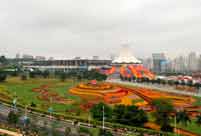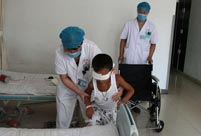Two folk painters in northeast China's Liaoning Province have created a large painting illustrating Japanese germ warfare atrocities during World War II.
An Yubing, one of the painters, said the three-meter-long and two-meter-high painting is the first of its kind in China depicting the crimes of Unit 731, the Japanese army's biological warfare unit.
In the painting, five Japanese military doctors in white attempt to take organs from a live woman's chest, with bloody limbs littered in buckets and dozens of injured victims watching nearby.
The artists began painting the piece two years ago and completed the work on Aug. 15, the 68th anniversary of China's victory in the Resistance War Against Japanese Aggression, An said.
Both of the painters are from Shenyang City, where Japanese troops began invading China on Sept. 18, 1931.
According to An, he and his partner, Dong Yonghua, were shocked when they visited the ruins of Unit 731 in the city of Harbin in 2011 and decided then to create the painting.
Unit 731 was established as a top-secret biological and chemical warfare research base in Harbin in 1935 and served as the nerve center of Japan's biological warfare in China and Southeast Asia during the World War II.
More than 10,000 civilians and war prisoners from China, the former Soviet Union, the Korean Peninsula and Mongolia died as subjects of experiments conducted at Unit 731. The Japanese blew up the base when the Soviet Union army regained Harbin in 1945.
 Mountain of garbage in Nairobi
Mountain of garbage in Nairobi Highlights of MAKS 2013 Int'l Aviation and Space Show
Highlights of MAKS 2013 Int'l Aviation and Space Show  10th China-ASEAN Expo opens in Nanning
10th China-ASEAN Expo opens in Nanning Eagle Boy takes to sky to break another record
Eagle Boy takes to sky to break another record 12-year-old boy becomes pillar of the family
12-year-old boy becomes pillar of the family Eye-gouged boy receives blind rehabilitation in Shanxi
Eye-gouged boy receives blind rehabilitation in Shanxi Top 10 naked hotels in the world
Top 10 naked hotels in the world The most gorgeous Chinese women in the eyes of foreigners
The most gorgeous Chinese women in the eyes of foreigners A collection of bizarre rooftop buildings around China
A collection of bizarre rooftop buildings around China Putin intimate contacts with marine animals
Putin intimate contacts with marine animals China's frigate 'Bengbu'in fire training
China's frigate 'Bengbu'in fire training Fresh students 'forced' to register in university independently
Fresh students 'forced' to register in university independently 2013 Taiwan Int'l Tourism Expo kicks off in Taipei
2013 Taiwan Int'l Tourism Expo kicks off in Taipei Photo story: Take a gap year
Photo story: Take a gap year Nokia's Global Headquarters: visiting a declining empire
Nokia's Global Headquarters: visiting a declining empireDay|Week|Month